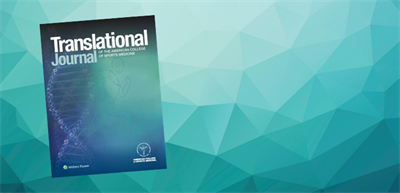John Bartholomew, Ph.D., FACSM |
Jan.
24, 2020

How do we put science to use for the betterment of society and to improve individual lives? This is the central question of translational science. For the Translational Journal of the American College of Sports Medicine (TJACSM), this question is focused on achieving this impact through exercise science and the study of human movement. As we look back on 2019, the articles that appeared in TJACSM are notable for their breadth of population studied and outcomes measured. While I could highlight each of the articles and their contribution, I will focus on a small number of articles to illustrate the impact of TJACSM.
Two of the top accessed articles focused on female athletes. Michaelson and colleagues studied female college soccer players and their response to different recovery models for high intensity interval training (HIT). Weir and colleagues tested the efficacy of a 2-year ACL injury prevention program for elite female field hockey players. Both studies illustrate the importance of translational research and its direct impact the performance of elite female athletes.
TJACSM also seeks to drive the research agenda through timely reviews and commentaries. The September 1st issue was focused on school-based interventions with guest editor Vazou Spyridoula. As she noted in her introduction, the evidence to date demonstrates the benefits of increasing physical activity during the school day – as such, the research must move to better understand how to implement these interventions with fidelity. Similarly, the epidemiological and laboratory evidence for Exercise is Medicine (EIM) is clear. What is not clear is how to best intervene in clinics to support this initiative. Bowen and colleagues help to focus this research agenda by describing the challenges for implementing EIM and suggesting opportunities for research to overcome these challenges.
Finally, cutting edge research generates discussion and TJACSM provides the space for these interactions. Brown and colleagues presented data from a phased exercise program that is modified for cancer survivors at different stages of recovery. This generated comment from Neil-Sztramko and Weller along with a response and additional data from Hayward, Brown and colleagues. This interaction amongst scholars is a critical component of the scientific process and will always be supported by TJACSM.
As we begin 2020, TJACSM will continue to publish all aspects of translational research for exercise science and human movement. This research will run the gamut from pilot and feasibility studies, to outcomes and process evaluations and scoping reviews to policy papers. I am excited to see what the best translational research will bring and share that research with our readers.
Most Read Articles of 2019
Effects of Two Different Recovery Postures during High-Intensity Interval Training.
"My Best Memory Is When I Was Done with It": PE Memories Are Associated with Adult Sedentary Behavior.
Exercise Is Medicine as a Vital Sign: Challenges and Opportunities.
Exercise Professionals in the Cancer Center: Experiences, Recommendations, and Future Research.
Time to Elevate the Education of Clinical Exercise Physiologists: A Professional Doctorate Model.
A 2-yr Biomechanically Informed ACL Injury Prevention Training Intervention in Female Field Hockey Players.
Perspectives on High School "Pay to Play" Sports Fee Policies: A Qualitative Study.
A Review of Acute Physical Activity Effects on Brain and Cognition in Children.
Evaluation of an Exercise-Based Phase Program as Part of a Standard Care Model for Cancer Survivors.
The Ubiquity of the Screen: An Overview of the Risks and Benefits of Screen Time in Our Modern World.
 John Bartholomew, Ph.D., FACSM, began his four-year term as editor-in-chief of TJACSM on January 1. Dr. Bartholomew currently serves as professor and chair of the Department of Kinesiology and Health Education at The University of Texas at Austin. His research centers on the development of school-based interventions to increase physical activity and the benefits of such interventions for academic performance.
John Bartholomew, Ph.D., FACSM, began his four-year term as editor-in-chief of TJACSM on January 1. Dr. Bartholomew currently serves as professor and chair of the Department of Kinesiology and Health Education at The University of Texas at Austin. His research centers on the development of school-based interventions to increase physical activity and the benefits of such interventions for academic performance.